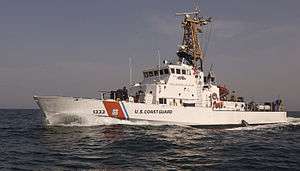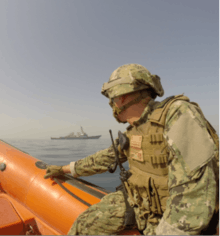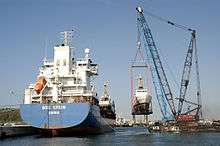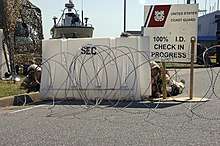Patrol Forces Southwest Asia
Patrol Forces Southwest Asia or PATFORSWA is a United States Coast Guard command based in Manama, Bahrain. PATFORSWA was created in November 2002 as a contingency operation to support the U.S. Navy with patrol boats. The command's mission is to train, equip, deploy and support combat-ready Coast Guard forces conducting operations in support of Operation Iraqi Freedom (OIF), Operation Enduring Freedom (OEF) and Operation Inherent Resolve (OIR) in the Naval Forces Central Command’s area of responsibility.[1][2][3] It was commissioned as a permanent duty station in June 2004.[4] In July 2003 PATFORSWA moved from its own compound to facilities at Naval Support Activity Bahrain.[5]

.jpg)
Elements
Patrol boats

There are six Coast Guard 110' Island class patrol boats assigned to PATFORSWA: USCGC Adak (WPB-1333), USCGC Aquidneck (WPB-1309), USCGC Baranof (WPB-1318), USCGC Maui (WPB-1304), USCGC Monomoy (WPB-1326), and USCGC Wrangell (WPB-1332).[6] The Coast Guard currently plans to base four new Sentinel-class cutters in Bahrain to replace the aging Island-class cutters.[7]
Unit History
Establishment
Initial preparations for naval operations supporting OIF began with the U.S. Navy in the summer and fall of 2002. The navy drew upon its standing contingency plans for combat operations involving Iraq and, in September 2002, United States Naval Forces Central Command (NAVCENT) requested U.S. Coast Guard support for a mission termed “Operation Iraqi Freedom.” The navy saw the Coast Guard's cutters and skilled personnel as ideally suited to naval operations supporting Operation Iraqi Freedom. The shallow coastal areas and waterways of Iraq are subject to heavy silting and strategists believed that Iraq's primary threat to American naval units came from small boats, patrol craft and mine laying vessels. The Coast Guard's patrol boats would expand the naval presence to shallow littoral areas where larger naval combatants could not navigate and Coast Guard cutters could remain on station for days as opposed to only a few hours typical of the navy's Special Forces boats. In addition, the law enforcement background of Coast Guard personnel would expand the Navy's ability to intercept and board Iraqi vessels and Coast Guard cutters could serve in force protection and escort duty, thereby freeing naval assets to conduct offensive combat operations.
The Navy called on the Coast Guard to perform missions that have always formed part of the service's peace-time mission. The Navy had very limited capability in boarding, maritime interdiction and even environmental protection and yet operations in Iraq would require units trained in these operations. As a result, the Coast Guard's Port Security Units (PSUs), Law Enforcement Detachments (LEDETs), National Strike Force (NSF), cutters and a variety of other units and personnel deployed overseas to support military operations in OIF. These units included cutters assigned to provide escort and force protection to battle groups and Military Sealift Command (MSC) convoys passing from the Strait of Gibraltar to the eastern Mediterranean.
As it had in previous American combat operations, the Coast Guard conducted operations well suited to cutters and their crews. The maritime conditions of Iraq and the Persian Gulf can greatly limit the operations of most naval vessels and warships. U.S.-led Coalition forces that allied against the Iraqi regime of Saddam Hussein included Gulf-based nations that had their own coast guard forces. However, these particular Coalition forces dedicated the use of their smaller vessels to protecting Kuwait, rather than operations in Iraqi territorial waters. Due to this and the Coast Guard's expertise in littoral and shallow-water operations, a large part of the request by United States Central Command (CENTCOM) centered on the Coast Guard's smaller patrol boats. Although various Coast Guard units and personnel had served in Operations Desert Shield and Desert Storm in the 1990s, deployment of the service's island-class patrol boats overseas would represent the first combat deployment of Coast Guard patrol boats since the Vietnam War.
Even though the Coast Guard served a similar mission in Vietnam, there existed no operational plan to provide guidance for OIF planning and preparations. The Coast Guard began its earliest preparations in the final months of 2002 and the lack of any pre-existing plan or blueprint for this sort of mission proved the Coast Guard's greatest challenge. The service's Atlantic Area Command (LANTAREA), headquartered in Portsmouth, Virginia, created a shore detachment to support its cutter operations overseas. These patrol forces detachments would oversee all aspects of operational support, including cutter maintenance and crew rotation. In October, LANTAREA created a shore detachment to oversee personnel, supply and maintenance requirements for patrol boat operations in the Persian Gulf. It designated this detachment as Patrol Forces, Southwest Asia (PATFORSWA). LANTAREA assigned an officer in charge (OIC) of PATFORSWA and selected four 110-foot Island-class patrol boats (WPBs) for the mission based on their superior maintenance records. These WPBs included Adak, Aquidneck, Baranof and Wrangell. LANTAREA created a second shore detachment for patrol boat operations in the Mediterranean; designated it Patrol Forces, Mediterranean (PATFORMED); and selected four more patrol boats for Mediterranean service. These WPBs included Bainbridge Island, Grand Isle, Knight Island and Pea Island.[8]
In 2004, two additional WPBs, Monomoy and Maui, were brought to the PATFORSWA fleet for a total number of six Coast Guard Patrol Boats in the Persian Gulf.
PATFORMED

The Coast Guard deployed its PATFORMED patrol boats in similar fashion to the PATFORSWA 110s. WPBs Bainbridge Island, Grand Isle, Knight Island and Pea Island arrived at Augusta Bay, Sicily, after a one-month transit on board BBC Spain. It took a monumental effort by PATFORMED support staff to prepare for patrol boat operations in the Mediterranean because no Coast Guard infrastructure existed in the region.
In the Mediterranean, Coast Guard operations supported naval and Military Sealift Command operations in the region. During combat operations in the Persian Gulf, PATFORMED patrol boats supported naval operations in the Mediterranean. The WPBs’ primary mission had been to escort navy supply vessels and Military Sealift Command ships out of Souda Bay, Crete, the eastern Mediterranean's logistics port for American and NATO forces. The naval command cancelled this mission when Turkey would not support the use of its territory for supplying a northern front in Iraq. The four cutters then came under the operational command of the Navy's Task Force 60 for Leadership Interdiction Operations (LIO) in the eastern Mediterranean. This mission required the cutters to cut off a waterborne escape route for Iraqi leaders fleeing through Syria and into the Mediterranean. Syria, however, agreed to seal its borders, cutting off the escape route through its territory to the Mediterranean coast. Shortly after Syria closed its borders, the Sixth Fleet released the PATFORMED cutters from operations in the Mediterranean, the cutters then returned to United States.[8]
Maritime Engagement Team (MET)

The Maritime Engagement Team (MET) is responsible for providing specialized law enforcement training to all cutters in theater and certifying their Level II Non-Compliant Boarding Teams. They also regularly augment other teams and assets in theater and perform boardings in the Persian Gulf, train foreign military units throughout the region, and conduct demonstrations for visiting VIPs.[4]
Redeployment Assistance Inspection Detachments
Redeployment Assistance Inspection Detachments (RAID) consisted of Coast Guard members deployed with the U.S Army to support the shipment of materials in and out of war zones. Their mission was to assist the Department of Defense with the safe re-deployment of containerized cargo as well as the storage and segregation of hazardous materials. The Coast Guard's goal was to ensure that hazardous material was properly prepared for shipment and re-entry to U.S. ports. The team moved between Forward Operating Bases, making them among the few Coast Guardsmen to have been so far forward with the U.S. Army in a combat zone.[4]

The first RAID was deployed in 2003 and they were brought under the PATFORSWA command structure in 2010. The Raid was demobilized in May 2015. [9]
Shoreside Support and Security

Shoreside personnel augment and share responsibility for all cutter maintenance, much like a Maintenance Assistance Team and a Sector. In addition, all shoreside personnel provide Anti-Terrorism Force Protection (ATFP) support. To most observers, the Boat Division remains the most visible element of a PATFORSWA. The ATFP shore support team is tasked to provide protection to vessels in security zones and pier areas. They also provide security for internal unit functions such as the Command Center, Communications Center, berthing areas, Entry Control Points (ECPs), Vehicle Control Points (VCPs) and traffic control/vehicle movement.[4] [4]
2016 U.S. Iran Naval Incident
Referred to as the 2016 U.S.–Iran naval incident. PATFORSWA played an integral role on the rescue of the U.S. Navy Sailors. January 12, 2016, two United States Navy riverine command boats (RCBs) cruising from Kuwait to Bahrain with a combined crew of nine men and one woman on board strayed into Iranian territorial waters[10] which extend three nautical miles around Farsi Island in Persian Gulf.[11][12][13] Patrol craft of Iran's Islamic Revolutionary Guard Corps (IRGC) Navy[14] seized the craft and detained the crew at a military base on Farsi Island.[15]

According to military sources, the two RCBs were on a routine transit from Kuwait to Bahrain, which serves as the home port for Task Force 56 under the Fifth Fleet. They left Kuwait at 12:23 p.m local time and were scheduled to refuel with the U.S. Coast Guard Island Class Patrol Cutter USCGC Monomoy (WPB-1326) at 5 p.m. During the transit one RCB developed an engine problem, and both boats stopped to solve the mechanical issue. During this time they drifted into Iranian waters. At 5:10 p.m. the boats were approached by the two small Iranian center-console craft followed by two more boats. There was a verbal exchange between the Iranian and U.S personnel and the officer commanding the RCBs allowed the Iranian sailors to come aboard and take control. The Iranian forces made the sailors kneel with their hands behind their heads.[16] The RCBs reported their engine failure to Task Force 56, and all communications were terminated after the report. A U.S. search-and-rescue effort was launched leading to "robust bridge-to-bridge communications" with Iranian military vessels, wherein the Iranians informed U.S. Navy cruiser USS Anzio at 5:15 p.m that “the RCBs and their crew were in Iranian custody at Farsi Island and were safe and healthy.”[17] By the time a search-and-rescue effort got under way (it included sending a U.S. Navy and U.S. Coast Guard vessel inside Iranian territorial waters over concern U.S. sailors could have been lost overboard), the sailors were already ashore.[10]
John Kerry spoke with Iranian foreign minister Mohammad Javad Zarif at least five times by telephone.[18] He called Zarif within five minutes. He states he "gave him a very direct statement about what would happen if we didn't have their release very quickly." Zarif called back within 20 minutes with assurances that the sailors would be released soon and that they were being "well taken care of."[19] John Kerry has stated that in his other phone calls about the situation he "made it crystal clear" how serious it was and that "it was imperative to get it resolved." The sailors had a brief verbal exchange with the Iranian military[13] and were released unharmed along with all their equipment [18] the next day on January 13 after 15 hours,[11] and they departed the island at 08:43 GMT on their boats. They later were escorted by a U.S. Coast Guard patrol cutter, while U.S. Navy overwatched and supported. The Pentagon oversaw the escort on high alert.[13]
The IRGC stated that they released the sailors after their investigation concluded the “illegal entry into Iranian water was not the result of a purposeful act.”[20]
U.S. Central Command stated, "A post-recovery inventory of the boats found that all weapons, ammunition and communication gear are accounted for minus two SIM Cards that appear to have been removed from two handheld satellite phones."[21] The statement did not account for navigation equipment. A Navy command investigation continues and more details will be provided when it is completed.[22]
The U.S. Navy disciplined and/or reprimanded nine of the Navy men involved in the incident, ranging from higher commanders to sailors present on the boats.[23][24]
See also
References
- http://www.navy.mil/search/display.asp?story_id=24853 PATFORSWA Changes Command
- "Patrol Forces Southwest Asia". www.atlanticarea.uscg.mil. Retrieved 4 September 2019.
The Mission of PATFORSWA is to train, organize, equip, support and deploy combat-ready Coast Guard Forces in support of CENTCOM and national security objectives.
- "PATFORSWA: Guardians of the Arabian Gulf". coastguard.dodlive.mil. Retrieved 4 September 2019.
PATFORSWA also supported Operation Enduring Freedom and in 2015 transitioned to supporting Operation Inherent Resolve.
- http://www.uscg.mil/psc/epm/PATFORSWA.asp PSC: Enlisted Personnel Management
- http://www.uscg.mil/history/articles/OIF_History.asp Operation Iraqi Freedom & the U.S. Coast Guard
- http://www.uscg.mil/hq/capemay/UIS/PATFORSWA/CGC%20AQUIDNECK.doc PATFORSWA unit information
- "House, Senate Defense Bills Tough on Littoral Combat Ship Programs". news.usni.org. Retrieved 4 September 2019.
The U.S. Coast Guard is already planning to base four fast response cutters in Bahrain, to replace the aging Island-class patrol boats the service currently has patrolling the Persian Gulf.
- https://media.defense.gov/2017/Jul/02/2001772360/-1/-1/0/USCGINOIF.PDF
- http://cgvi.uscg.mil/media/main.php?g2_itemId=95873 Operation Iraqi Freedom
- Barbara Starr, Ryan Browne (15 January 2016). "Ash Carter: 'Navigational error' behind U.S. sailors ending up in Iran". CNN. Retrieved 13 February 2016.
- "U.S. sailors captured by Iran were held at gunpoint: U.S. military". Reuters. 18 January 2016.
- "Iran's Swift Release of U.S. Sailors Hailed as a Sign of Warmer Relations". The New York Times. 14 January 2016.
- "US Navy sailors released unharmed by Iran in less than a day". Associated Press. 13 January 2016.
- McGarry, Brendan. "GPS Devices Taken from Captured US Naval Boats Working, Iran Says". Military.com. Retrieved 2016-01-24.
- Staff writers. "Two US Navy boats in Iranian custody – Pentagon". RT International. Retrieved 26 January 2016.
- Lyons, James. "Seagoing coincidence? Navy's Iran mishap boosts image of Obama diplomacy". The Washington Times. Retrieved 27 January 2016.
- "JAMES LYONS: Navy's Iran mishap boosts image of Obama diplomacy". The Washington Times. Retrieved 2016-02-25.
- Friedman, Uri. "The U.S.-Iran Conflict That Never Happened". The Atlantic. Retrieved 26 January 2016.
- Goodenough, Patrick. "Kerry: If It Weren't For My Relationship With Iran's Zarif, Our Sailors Would Probably Be Hostages". CSN News. Retrieved 9 March 2016.
- Fred Barbash (13 January 2016). "Iran releases captured U.S. Navy crew members". Washington Post.
- "U.S. Central Command Statement on Events Surrounding Iranian Detainment of 10 U.S. Navy Sailors on Jan. 12–13, 2016". U.S. Central Command. 18 January 2016. Archived from the original on 26 January 2016. Retrieved 20 January 2016.
- "US Central Command statement on events surrounding Iranian detainment of 10 US Navy Sailors Jan. 12–13, 2016". U.S. Central Command Public Affairs. Retrieved 31 January 2016.
- https://www.nytimes.com/2016/07/01/world/middleeast/us-navy-iran.html
- https://www.bbc.com/news/world-us-canada-36678976